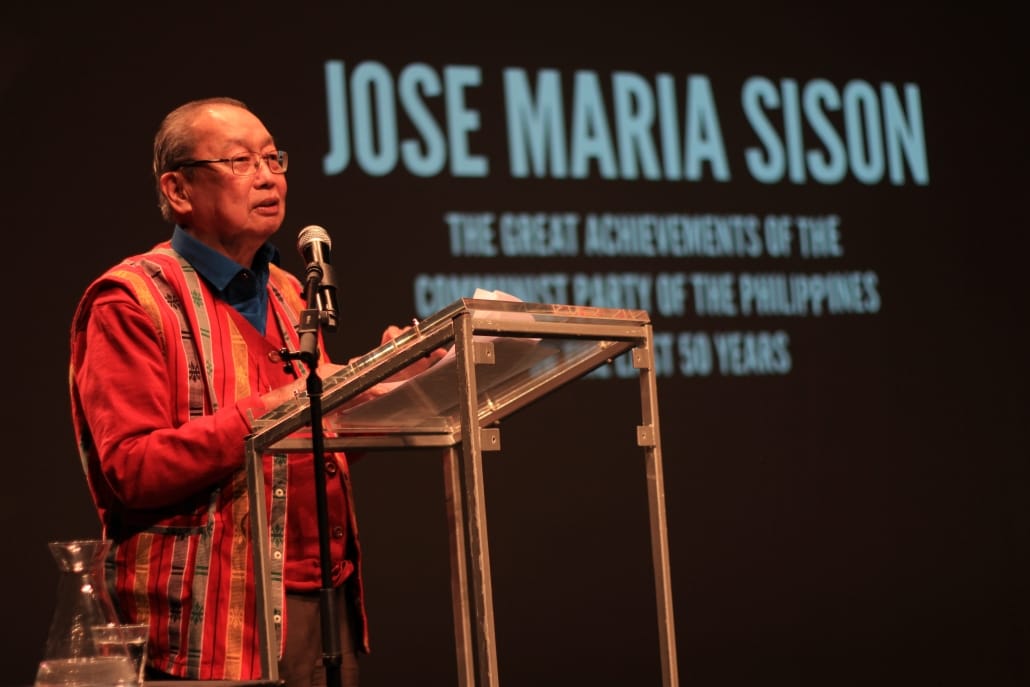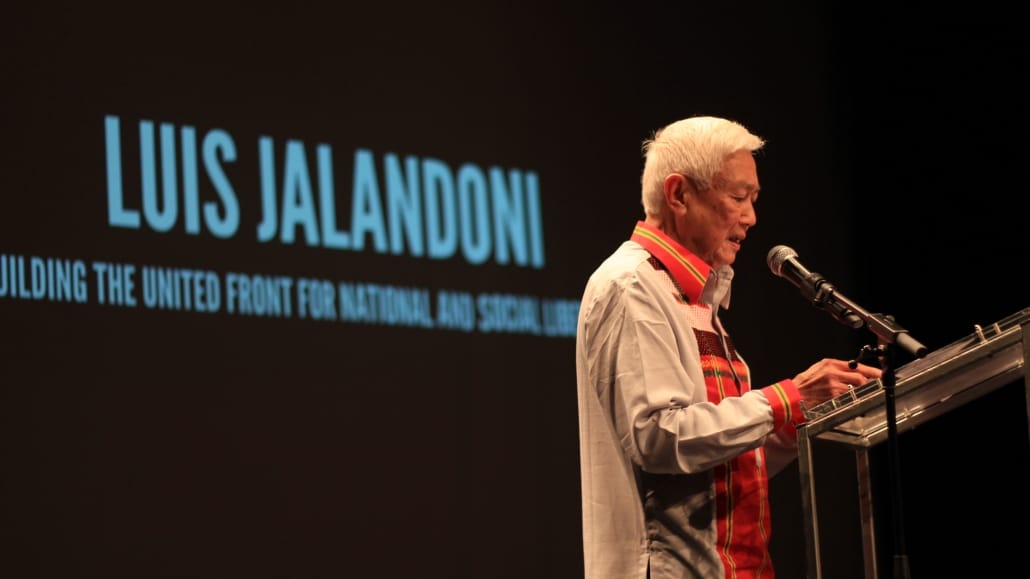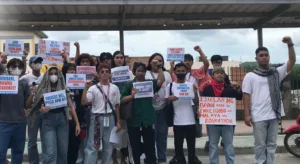29 December 2018

(Utrecht, The Netherlands) – Hundreds of cultural workers, youth, human rights and political activists, artists, academics, Filipino and other migrant nationalities and representatives of political parties and formations from all over the world, jampacked the auditorium of center for art and culture in this central Dutch city to celebrate “Fifty Years of Art and Culture in the Filipino People’s Struggle for National and Social Liberation” and the anniversary of the founding of the Communist Party of the Philippines (CPP) on December 26, 1968.
The celebration was organized by the National Democratic Front of the Philippines (NDFP) International Information Office in Utrecht, together with the Linangan Art and Culture – a network of young cultural workers and artists in the Netherlands. The Basis voor Actuele Kunst (BAK) – a leading international platform for theoretically-informed, politically-driven art and experimental research, hosted the event.
The celebration which began in the morning, was highlighted with an exhibition of art works, performances and publications, video installations and film-showings produced in the course of the struggle of the Filipino people for national and social liberation.
The celebration was capped with speeches by Prof. Jose Maria Sison, Founding Chairman of the CPP, and NDFP chief political consultant, who spoke on the achievements of the revolutionary movement in the past 50 years; Luis Jalandoni, NDFP peace panel senior adviser, who gave a speech on building the third weapon of the revolution, the united front, and Coni Ledesma, NDFP peace panel member, who spoke on the road to a just and lasting peace.
A one-minute video on “What is Peace” preceded Ledesma’s speech. A choral singing of “Martsa ng Bayan” (March of the People) preceded Jalandoni’s talk, and a dance interpretation of the poem and song “NorthStar” preceded Sison’s input.

Earlier during the day, Julieta De Lima, NDFP peace panel member, gave a premier lecture on the role of art and culture in the struggle of the Filipino masses for national and social Liberation, and the role of the masses in the development of revolutionary art and culture.
The solidarity program included heartwarming and revolutionary performances by young militant cultural workers from the Philippines, Netherlands, the US, Canada, Belgium, Turkey, and Italy. They rendered revolutionary songs, dances that included the contemporary and traditional lumad (indigenous) dance, choric reading, and theater performances depicting the triumphs of the people’s army in the Philippines. These performances were always accompanied by visual presentations on the people’s struggle.
Representatives from many organizations in the Netherlands, Belgium, Denmark, France, Germany, Italy, Austria, Iceland, Norway, Peru, United Kingdom, Switzerland, the US and Canada, India, Mexico, Turkey, and Indonesia attended. The Embassy of Venezuela in The Hague also sent a representative.
Solidarity messages from political parties and formations from the Netherlands, Belgium, Denmark, Germany, France, Italy, Austria, Greece, Turkey, Kurdistan, Mexico, Argentina, Australia, Norway, Indonesia, the US and Canada. Chants of “Viva CPP-NPA-NDF!” and “Mabuhay ang CPP!” interspersed the reading of the solidarity messages from the friends of the Filipino people.
The film “Revolution Selfie: The Red Battalion” by American filmmaker Steven De Castro who tackled the portrait of the 48 year-old people’s army in the Philippines, and the documentary film “Moving Mountains” which tackles the life stories of the pioneers of the Philippine Revolution and the future of the protracted people’s war, were also shown earlier in the day.

During the solidarity program, youth organizations in the Netherlands gave a special recognition to Prof. Sison and Julie de Lima, for being among the most outstanding pioneers of the Philippine revolutionary movement and a guiding inspiration for young revolutionaries, particularly young guerrillas of the people’s army. They gifted Joma and Julie with bouquets of flowers and a Mao pen and Mao’s original classic “Red Book”. Youth activists in the audience chanted “ang karit at maso, dudurog sa estado” (the peasant sickle and worker’s hammer, will crush the state) as the couple received a standing ovation.
As a tribute, a moving video collage of contemporary Filipino revolutionaries – poets, human rights workers, cultural activists, writers, movie directors, academics, militant priests and nuns, solidarity workers, and NPA guerrillas who have passed on, became missing, killed by the Philippine military or died as guerrilla fighters and combatants, was shown.
The evening of celebration concluded with the community singing of the workers’ anthem “Internationale” while a video of exiled NDFP leaders singing the same song was also played, and was followed by a celebratory dance with indigenous music participated in by the Filipino migrants and their children who were garbed in indigenous attire from the Cordilleras and Mindanao.
“The pen and the gun: weapons for a successful revolution” – Juliet de Lima
In her presentation titled “On the Pen and the Gun”, Julie de Lima paraphrased Mao Zedong who wrote: “to defeat the enemy, we rely primarily on the people’s army wielding the gun. But this is not enough, we must also have an army wielding the pen.”
De Lima says: “It is significant that Mao mentioned the pen first before the gun. Our experience shows that we must first arouse before we can organize and then mobilize people, whether it is taking up the pen, or the gun, or further, the gun and the pen. Reviewing its 50 years of uninterrupted revolutionary struggle, we can say that the CPP has been successful in wielding both weapons.”
De Lima cites the CPP’s cultural achievements since its founding in 1968 and its impact and influence on the cultural and artistic endeavors on Philippine society and the people’s revolutionary struggle.
She proceeds by comprehensively and eloquently tracing the historical experience of the Filipino people starting with the old democratic revolution, the First Propaganda Movement, well into the Second Propaganda Movement the CPP’s first, second and continuing rectification movement which is essentially an education movement, until the current age of the internet and multimedia.
De Lima called on the people and revolutionaries to “contribute to the peoples’ unified cultural offensive against imperialism, aware that its overwhelming dominance necessitates strong organizations with strong leaderships guided by the ideology, politics and methods of a party of the most advanced and most productive class in our society.”
It is not enough for us, she emphasized, to compete with the imperialists in such superficial terms such as trending hashtags, viral Youtube views and TV ratings, but to build long-term results with the growth by leaps and bounds of the anti-imperialist mass organizations and mass movement at the national and international levels.
“The essential task of the progressive and revolutionary forces all over the world today is developing unity, cooperation and coordination of all peoples and raising their level of struggle to weaken and defeat imperialism and reaction towards building a society that is just, peaceful and progressive,” De Lima concluded.
In reaction to De Lima’s paper, Lisa Ito of the Concerned Artists of the Philippines (CAP) and professor of the College of Fine Arts at the University of the Philippines stressed that the “ongoing Philippine revolution—in the 70 years from 1898-1968 and in the 50 years from 1968-2018—is one that continuously resists, rectifies, and renews itself: against capitulation, against collaboration, and always for the advance of national liberation. De Lima makes clear how, since its humble origins in 1968, the Party achieved all these contributions through correct analysis, practice, and rectification.”
She says in her reaction paper entitled Key Words: Notes on Manifestoes for the Future, De Lima’s stories teach us how we must learn to be self-reliant and daring in waging the cultural and propaganda counter-offensive, in the same way the activists of the First Quarter Storm did: by vigorously and systematically pursuing study, production, translation, and dissemination to break the normalization of fascism and to now prevent another tragic return to authoritarian rule.
There is an urgency to overcoming this learning curve. For the world we inhabit now is not the same as the world back in 1968. Most of the technology present today did not exist then: including computers, the Internet, electronic and digital media, video, data visualization, cybernetics, and social media platforms. These are but a fraction of technologies imagined and invented for agriculture, industry, medicine, scientific inquiry, and war. These technologies make today’s state of material and mental or cultural production possible and are developing at a rate unimaginable fifty years ago. But they will also remain largely in control by the ruling regimes unless channeled towards revolutionary practice, Ito says.
In concluding her reaction to De Lima , Ito says: A good friend and comrade recently described cultural work not in terms of its surface forms or strategies, but as a selfless act and process. If there is anything this and the 50 years of culture and resistance teaches us, it is that drawing the line of the revolutionary is also an immense assertion of love. Cultural work in the revolution transforms individualism, which reenacts the status quo on personal or structural levels, into a radical force that finds its fullest potential in being one with the struggles of the people.
Dr. Joi Barrios, another reactor to De Lima’s paper maintained in a video message after De Lima’s input, that as De Lima’s speech traces the cultural achievements of the Party, it provides us with the following five frames by which we can discuss the revolutionary art and literature produced in the past fifty years: historical and contemporary contexts; organizational commitment and the process of creation; centrality of language; exploration and appropriation of forms and spaces; and solidarity work with allied artists and writers.
Emphasizing the need for solidarity with allied and other artists, Dr. Barrios who teaches at the University of Berkeley in California, says that we celebrate today not only the work of those we can name, such as National Artists Amado V. Hernandez, Lino Brocka and Ishmael Bernal, not only the unnamed cadres who have achieved national stature for their artistic and literary achievements, not only the creativity of our current army of writers and artists, but also the countless allies we have in theater, music, dance, visual arts, media arts, and literature.
The sustained creation of revolutionary art and literature, Dr. Barrios says, allows us to envision what Julie de Lima describes as the triumph of a “unified cultural offensive of the people against imperialism” towards a “just, peaceful, and progressive society.”
“No matter the pronouncements of the current dictator, fascist regimes cannot annihilate our persistent radical bodies, nor our revolutionary texts,” Dr. Barrios concludes.
In her talk “The Road to a Just and Lasting Peace”, Coni Ledesma asserts that we can only attain a just and lasting peace by waging our national democratic revolution. Or another way of putting it is: the national democratic revolution is also a struggle for a just and lasting peace. Waging peace is another form of struggle for national and social liberation.
“The road to a just and lasting peace is not a paved and smooth road, as seen during the last 32 years. But our goals are clear. No matter how difficult, no matter the hardships, with great patience and commitment, we continue to pursue the peace. Because one day, there will be just and lasting peace, when the Filipino people win their liberation,” Ledesma emphasized.

Luis Jalandoni’s focused on “Building the United Front for National and Social Liberation”. He says the United Front is necessary to develop the broadest possible alliance and reach immediately the people in their millions in order to effectively confront and defeat US imperialism, the big compradors and landlords, and the bureaucrat capitalists. They control the reactionary state machinery and its military, police and paramilitary forces.
Carrying out creatively this united front policy in the countryside, Jalandoni says the CPP carries out agrarian revolution, mass base building, and launches tactical offensives. These are waged on the basis of an ever deepening and expanding mass base. Organs of political power are set up on the basis of revolutionary mass organizations of workers, peasants, women, youth, indigenous people and other sectors.
The organs of political power are the firm foundation of the People’s Democratic Government (PDG) that provides essential services to the people, such as land reform, increased productivity, health, education, protection from enemy attacks, arbitration and justice, cultural work, disaster relief and environmental protection.
He asserts that in the face of the brutal attacks of the US-Duterte regime, the united front needs to be further broadened and strengthened. The united front is concretized in the consolidation of the National Democratic Front of the Philippine and its 18 allied organizations. Other supportive organizations and alliances in the whole country are also very important.
Internationally, Jalandoni says, the revolutionary movement engages in mutually beneficial solidarity and cooperation to win support as well as extend support to other movements. It is ever ready to contribute to the strengthening of the worldwide anti-imperialist movement and the international campaign to build socialism.
Duterte would be politically destroyed before he could destroy the revolutionary movement – Jose Maria Sison

Delivering the main speech of the celebration “Great Achievements of the CPP in Waging 50 years of Revolution”, Sison sums up the achievements of the Party, thus:
The CPP has systematically strengthened itself ideologically, politically and organizationally. It arose with only a few scores of cadres and members from the revolutionary mass movement of the 1960s. It has become nationwide and has become even more deeply rooted among the toiling masses of workers and peasants. It continues to draw strength from the revolutionary mass movement. It has grown into tens of thousands of cadres and members who have been tested and tempered in revolutionary armed struggle and other forms of struggle.
The CPP leads the New People´s Army (NPA), which it founded on March 29, 1969 in the second district of Tarlac. Now, this army operates in more than 110 guerilla fronts covering substantial parts of 73 out of the 81 Philippine provinces in 17 regions outside of the national capital region. It is assisted by the people´s militia and self-defense units of mass organizations. It follows the strategic line of protracted people´s war, carries out agrarian revolution and guarantees the building and functioning of the people´s democratic government.
The CPP leads the national united front whose most consolidated embodiment is the National Democratic Front of the Philippines (NDFP) founded on April 24, 1973. The national united front relies mainly on the revolutionary basic alliance of the working class and the peasantry, wins over the middle strata of the bourgeoisie and takes advantage of the conflicts among the reactionaries in order to isolate and defeat the enemy, which is the worst reactionary clique.
The united front is effective in reaching and rallying the people in their millions. It has demonstrated that it can overthrow the fascist dictatorship of Marcos in 1986 and the corrupt regime of Estrada in 2001. It is necessary to defeat one reactionary clique after another and thus increase the strength of the revolutionary movement for overthrowing the entire semicolonial and semifeudal ruling system, accomplishing the people´s democratic revolution and laying the basis for the socialist revolution.
Sison says that the regular people’s army is augmented by tens of thousands of people’s militias and hundreds of thousands of people’s defense units.
The protracted people’s war, Sison asserts, is transitioning from the middle phase to the advance stage of the strategic defensive.
Departing from his prepared written speech, Sison assails Philippine President Duterte for boasting that he could destroy the revolutionary movement in 2018. But Sison laughs this off by saying two days are left before the end of 2018 and the CPP and the revolutionary movement it leads is even growing stronger and drawing in more members and allies.
Sison also laughed off Duterte’s threat to use the widely-condemned Suharto-type of solution to eliminate the revolutionary movement. Sison says, in the first place, the CPP is clandestine and has a people’s army deeply-rooted in the broad masses of the people.
“Duterte would be politically destroyed before he could destroy the revolutionary movement, either he is ousted by his own military and the broad opposition and the people, or gives in to the pressure from the intensifying armed revolutionary resistance in the countryside,” Sison says.
The revolutionary movement, he asserts, would certainly outlast him.
In conclusion, Sison proclaimed to the audience that the Communist Party of the Philippines is a torchbearer of the world proletarian revolution.###






















